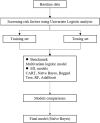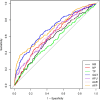Prediction Model for Familial Aggregated HBV-Associated Hepatocellular Carcinoma Based on Serum Biomarkers
- PMID: 40551431
- PMCID: PMC12185788
- DOI: 10.1002/cnr2.70253
Prediction Model for Familial Aggregated HBV-Associated Hepatocellular Carcinoma Based on Serum Biomarkers
Abstract
Background: Accurate assessment of the risk of familial aggregated hepatitis B virus (HBV)-associated hepatocellular carcinoma (HCC) and regular surveillance for these patients at high risk may be valuable to reduce the occurrence and improve the prognosis of HCC.
Aim: This study aimed to develop a simple and reliable prediction model for the risk of HCC in these patients.
Methods and results: This study analyzed clinical laboratory results from a database of 1285 patients with familial aggregated HBV who attended the First Hospital of Lanzhou University from January 2010 to December 2019. Univariate and multivariate logistic regression (LR) analysis showed that hemoglobin (Hb), neutrophil percentage (NP), total protein (TP), glutamyl transpeptidase (GGT), alglucosidase alfa (AFU), aspartate aminotransferase (AST) to Alanine aminotransferase (ALT) ratio (AAR), and alpha-fetoprotein (AFP) were identified to be independent risk factors for HBV-associated HCC. Prediction models were developed using a multivariate LR model, classification and regression tree, Native Bayes, Bagged tree, AdaBoost, and random forest. We used a multivariate LR model as a benchmark for performance assessment (AUC = 0.737). The results showed that the Native Bayes model had an AUC of 0.749, which was better than that of the other models.
Conclusion: Finally, the Native Bayes model demonstrated better predictive performance for HCC, which helped in the clinical decision-making and identification of HCC high-risk groups.
Keywords: familial aggregated HBV; hepatocellular carcinoma; machine learning; risk prediction.
© 2025 The Author(s). Cancer Reports published by Wiley Periodicals LLC.
Conflict of interest statement
The authors declare no conflicts of interest.
Figures



Similar articles
-
Surveillance of cirrhosis for hepatocellular carcinoma: systematic review and economic analysis.Health Technol Assess. 2007 Sep;11(34):1-206. doi: 10.3310/hta11340. Health Technol Assess. 2007. PMID: 17767898
-
Effect of combining serum alpha-fetoprotein with LI-RADS v2018 on gadoxetate-enhanced MRI in the diagnosis and prognostication of hepatocellular carcinoma.Eur Radiol. 2025 Aug;35(8):4957-4966. doi: 10.1007/s00330-025-11418-2. Epub 2025 Feb 10. Eur Radiol. 2025. PMID: 39930127
-
Predictive Value of Peripheral Blood Eosinophil Count on the Efficacy of Treatment with Camrelizumab in Combination with Lenvatinib in Patients with Advanced Hepatitis B-Associated Hepatocellular Carcinoma.Technol Cancer Res Treat. 2024 Jan-Dec;23:15330338241277695. doi: 10.1177/15330338241277695. Technol Cancer Res Treat. 2024. PMID: 39263703 Free PMC article.
-
Alpha-fetoprotein and/or liver ultrasonography for liver cancer screening in patients with chronic hepatitis B.Cochrane Database Syst Rev. 2003;(2):CD002799. doi: 10.1002/14651858.CD002799. Cochrane Database Syst Rev. 2003. Update in: Cochrane Database Syst Rev. 2012 Sep 12;(9):CD002799. doi: 10.1002/14651858.CD002799.pub2. PMID: 12804438 Updated.
-
Performance of the GALAD Model in an Asian Cohort Undergoing Hepatocellular Carcinoma Surveillance: A Prospective Cohort Study.J Gastroenterol Hepatol. 2025 Jul;40(7):1818-1824. doi: 10.1111/jgh.16997. Epub 2025 May 10. J Gastroenterol Hepatol. 2025. PMID: 40346978
References
-
- Sung H., Ferlay J., Siegel R. L., et al., “Global Cancer Statistics 2020: GLOBOCAN Estimates of Incidence and Mortality Worldwide for 36 Cancers in 185 Countries,” CA: A Cancer Journal for Clinicians 71, no. 3 (2021): 209–249. - PubMed
-
- Hanazaki K., Kajikawa S., Shimozawa N., et al., “Survival and Recurrence After Hepatic Resection of 386 Consecutive Patients With Hepatocellular Carcinoma,” Journal of the American College of Surgeons 191, no. 4 (2000): 381–388. - PubMed
-
- Nguyen A., Nguyen H., Yee K. C., Palmer A. J., Blizzard C. L., and de Graaff B., “A Systematic Review and Narrative Synthesis of Health Economic Evaluations of Hepatocellular Carcinoma Screening Strategies,” Value in Health 24, no. 5 (2021): 733–743. - PubMed
-
- EASL‐EORTC , “Clinical Practice Guidelines: Management of Hepatocellular Carcinoma,” Journal of Hepatology 56, no. 4 (2012): 908–943. - PubMed
-
- Marrero J. A., Kulik L. M., Sirlin C. B., et al., “Diagnosis, Staging, and Management of Hepatocellular Carcinoma: 2018 Practice Guidance by the American Association for the Study of Liver Diseases,” Hepatology 68, no. 2 (2018): 723–750. - PubMed
MeSH terms
Substances
Grants and funding
LinkOut - more resources
Full Text Sources
Medical
Miscellaneous

